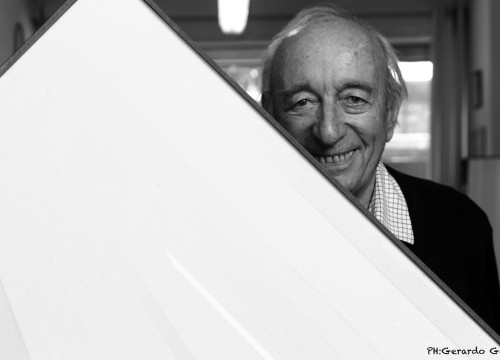The painter of light
At 88, the Master Relives a Time of Great Vitality and Creative Enthusiasm
We meet Riccardo Guarneri in his beautiful Florentine atelier. He comes to meet us with his slender figure, distinct mannerisms and always smiles. Moving with agility between canvases and memories, he observes the emotions that his work arouse in the observer attentively. At nearly 88, he fascinates us with his vitality and enthusiasm.
So, Maestro, you first devoted yourself to music.
At the age of twenty I was playing in a pop music orchestra and during a tour in Helsinki, Finland, when I began to devote myself to painting by chance. This interested me a lot and so, on returning to Florence, I deepened this research. I had a greater creative interest in painting allowed me than music which I ended up giving up. My debut took place in The Hague, Holland, in a gallery run by friends who were emerging avant-garde painters.
What is the origin of your color palette?
My cold colors have a dual origin: on the one hand they arise from the need to give the painting greater brightness, something that the warm color cannot do because, through a chromatic redundancy, it turns off the luster. Secondly, these colors probably derive from the trips made to Germany, Holland, Finland and Norway where there is this particular cold light that inevitably remained inside me.
What does gesture express in your works?
Gesture fascinates me because I have always considered it as drawing in all respects. My painting has this approach to gesture, which for me has an expressive character (be it nervous, lyrical, musical, etc.), even when its presence is marginal or when used repeatedly, it creates a graphic surface texture.
"I began to devote myself to painting by chance during a tour in Finland"
His precise painting does not seem to fit in with this chaotic society.
In the 1960s I was also interested in social, political and social movements pseudo-revolutionaries of the time. Despite this, I have never mixed ideology with art, as the neorealists who identified painting with the youth protest. Art was therefore on its own with its huge problems as well as the issues that I had with painting, such as my own fulfillment. I had to express what I felt inside and that I wanted to communicate to others.
Delicacy of light and a soft gesture seem to be your distinctive style.
For this, I am considered a romantic, a lyricist, unlike the other abstract painters (aniconici). I fell out of love with strong, rich colors: I am more interested in light reflected on a wall or on a car.

























